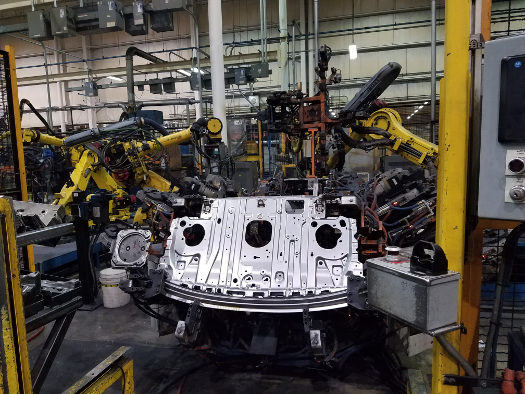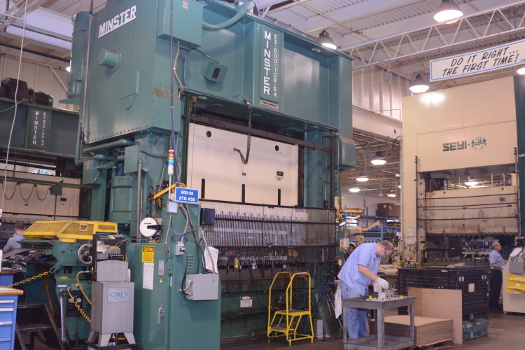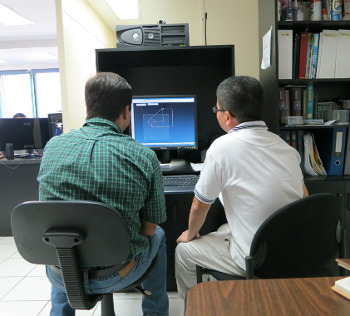 |
| December 13, 2016 | Volume 12 Issue 46 |
Designfax weekly eMagazine
Archives
Partners
Manufacturing Center
Product Spotlight
Modern Applications News
Metalworking Ideas For
Today's Job Shops
Tooling and Production
Strategies for large
metalworking plants
Design Software:
Manufacturing with a progressive edge
VISI from Vero Software helps Atlantic Tool & Die design complex progressive dies for the automotive industry.

Having found that its former solution was not keeping pace with an evolving manufacturing landscape, ATD switched to VISI because the solution could handle increasingly challenging design demands.
At Atlantic Tool & Die, the proof, and the success of the company, is in its processes.
"One thing that we really hang our hats on as a company is the process of how our dies are designed and built," says Jason Andras, Design Manager at Atlantic Tool & Die (ATD) for the past decade. "We really invest in how we process our tools."
While products and dies manufactured by ATD read like a veritable laundry list, the company primarily serves the automotive sector as a direct-to-OEM, Tier-1, and Tier-2 supplier.
Other products ATD manufactures are used to make home appliances, off-road vehicles, heavy trucks, and commercial-power and green-energy solutions, among others.
In addition to tool and die building, the company offers stamping, welding, assembly, and tube-manufacturing services.
"Our customers are relatively diverse, so we do have some variety, but it's primarily automotive, and primarily repeat customers," Andras says.
To fulfill its wide range of design and production demands, ATD employs a crew of 650 associates stationed around the globe. The company's host of facilities includes four stamping and assembly sites in Ohio; production facilities in Texas and Mexico; a die-building and production facility in China; a design and engineering outfit in Costa Rica; and a sales office in Tokyo, Japan.
While the number of dies built annually by the company is in the hundreds, it produces an average number of stamped parts in the millions per year.

ATD maintains busy shop floors that include four stamping and assembly facilities in Ohio, production facilities in Texas and Mexico, and a die-building and production facility in China.
In the early 2000s, ATD purchased the VISI CAD/CAM solution, by Vero Software, to fulfill its complex range of tool and die needs. The company receives CNC software support from Tooling Software Technology (TST), the Michigan-based master distributor for VISI in the United States and Canada.
"The support is excellent," Andras says of the service provided by TST. "They are quick to respond to any issues that arise, and the follow-through is better than any software support I've ever experienced. They will call and email until you verify with them that your issue is resolved."
Having found that its former solution was not keeping pace with an evolving manufacturing landscape, ATD switched to VISI because the solution could handle increasingly challenging design demands.
"As time went on and stamping got more complex, there needed to be a way to handle it," says Andras, who works in the company's headquarters in Strongsville, OH, but collaborates closely with its nine-member design team in Costa Rica.
"The software we use has to be complex enough to do what it needs to do, but simple enough that people who aren't engineers are able to visualize what they need to see. We can see how quickly our employees can pick VISI up as compared to the software that we have tried to use in the past."
Most notable, Andras says, "ATD's former software was limited in terms of simulation and in the creation of surfaces."
"Our simulation of what we were proving out in terms of our form sequences was a challenge," he says. "Regarding surfacing and modeling, I have yet to meet anyone who can do what our designers can do with VISI. The ease with which we can create complex surfaces in VISI is critical for us."
VISI delivers a dynamic, flexible structure within which designers are able to manipulate solids, surfaces, wireframes, or a combination of all three. VISI surfacing technology offers a varied set of tools and methods tailored to assist in an organic, free-form creation of geometry.
Surface modeling functions within VISI include ruled, lofted, drive, sweep, n-sided patch, drape, tangent, draft, resolved, and piped surfaces. Paired with the software's advanced editing capability, this varied set of modeling commands simplifies the process of healing imported geometry and constructed complicated 3D data.
As ATD primarily builds progressive dies, the company takes advantage of VISI's numerous strip-layout tools to quickly answer questions posed by customers.
"I spent a lot of time on the phone this morning because a customer expected to have a strip layout within a couple of hours," Andras says. "Our customers demand to have answers quickly, in terms of cost and design. We noticed that VISI stays up to date with the features we need, and that has made it easier to fulfill those demands."
Andras stresses, especially, that VISI helps ATD to quickly and easily create the company's strip layouts.
Beginning with the developed component blank, VISI makes it simple to rapidly generate an efficient 3D strip layout with its automatic blank alignment, rotation, and optimization tools.
The software also offers an automatic 2D strip plan, including fold lines, making both punch design and layout more effective.

Mario Guzman, right, of ATD, trains a colleague on the VISI CAD/CAM solution, by Vero Software. VISI was chosen by ATD to fulfill its complex range of tool and die CNC programming needs.
Designed to deliver flexibility and customization for the designer, VISI offers a range of automatic and semi-automatic capabilities that help with the generation of shearing punches. Once created, those punches may be dynamically moved to different stages in the strip with a simple drag-and-drop process.
Likewise, the positioning of 3D folding stages onto the strip is seamless, and the strip can just as easily accommodate reductions and increases in the number of stages. To test for the validity and performance of the design, the 3D strip can be simulated at any point in the design process.
Another tool used frequently by Andras and his team is the VISI assembly manager, which "works well to help organize the design," he says.
The assembly manager allows the designer to rapidly build a solid based upon the layout of the required bolster plates, along with pillar and brush arrangements. By providing access to the parameters of each plate, VISI ensures that the modification of the tool is fast and accurate. The tool assembly also includes critical data required for the operation of the press tool, including press stroke, strip stroke, punch height, and tool-stroke data.
VIDEO: Progressive die design using VISI CADCAM -- Overview. [NOTE: There is no sound for this video. To see more VISI videos, go to: www.visicadcam.com/videogallery/]
Andras also takes advantage of VISI's collision-detection capabilities, which alert the designer that the virtual design will run into very real trouble once it hits the shop floor.
"It's important to be able to see, when we design dies, that there may be a problem that we haven't anticipated," Andras says.
Source: Vero Software
Published December 2016
Rate this article
View our terms of use and privacy policy
